Registration not required for a work merely performed and existing in only one copy
 | ||
Universal quite properly registered East of Borneo for copyright. Joseph Cornell did not do so for his collage work, but he didn’t need to. As indicated on the illustrations page on publication (which has an illustrated section on this film; see bottom of page), the mere display or performance of a work does not constitute publication. Without publication, a work can enjoy protection as an unpublished work without need of formalities such as copyright notice and registration. (Beginning in 1978 and 1989, American law removed the requirements of copyright registration (1978) and notice (1989) on published works. These changes didn’t relieve requirements on earlier works published prior to those dates. Pre-1978 works continue to be bound by the earlier requirements. However, in that unpublished works such as Rose Hobart had remained unpublished during that period, they continued to enjoy copyright protection as unpublished works even without copyright notice and registration.) Rose Hobart confounded the audience who saw its first screening in 1936. The limited audiences who saw it in the 1960s reappraised it. Film critic J. Hoberman of the New York Village Voice named it on his list of ten films submitted to the 1992 edition of Sight and Sound magazine’s prestigious poll of greatest movies. An essay accompanying the film on the Treasures from American Film Archives DVD set (issued by the National Film Preservation Foundation, 2000) appraises Cornell’s achievement thus: “His film is named for East of Borneo’s lead actress, Rose Hobart, who becomes the locus of vague evocations of desire and dread. His edit is rough and disconcerting: Shots begin just as scenes are fading out, glances have uncertain objects, continuity is mismatched.” Citing a comment by Cornell that sound films tended to be vacuous, the essay remarks that, “Rose Hobart makes its critique on these terms: Hollywood fails in its banal screenplays, not its raw images.” The audience for Cornell’s wordless commentary of Universal’s original was obviously quite different from those Universal got to pay nickels and quarters for admission during the Great Depression. In 2001, the Librarian of Congress named Rose Hobart one of 25 additions to the National Film Registry. Prior to that year, only 300 films had been so honored. Most films named have been classic Hollywood feature films made by the most esteemed filmmakers. Cornell may seem an interloper among them, he having not touched a camera while making what amounts to “a rearranged found object.” When determining the copyright status of a work, a researcher needs to consider where and to what extent a work has been put forth before the public. A sculpture of which there is a single copy is an obvious example of work exhibited but not published. A motion picture that goes against the norm for motion pictures is not so obvious. Theatrical distribution is so frequently assumed that a single-print limited-exhibition film is not recognized as such. Films intended for “art” venues can catch the unwary off-guard. As much as it might seem that a movie with Hollywood stars would not be the property of a major art museum, it is a fact that Rose Hobart is booked and licensed by the Museum of Modern Art. Likewise, the popularity and long Hollywood career of slapstick comedian Buster Keaton can mislead some to assume all Keaton films were theatrically released in mass quantity and would require copyright registration to enjoy copyright. In fact, Keaton collaborated with modernist playwright Samuel Beckett on Beckett’s only film, self-referentially titled Film (1965), a carefully-choreographed wordless mood study incorporating Keaton’s visual comedy. Exhibited at festivals and museums, only one print circulated. Copyright registration was not required in the pre-video era. In the video era, automatic copyright protection applies to it. Further questions relevant to Rose Hobart involve the underlying copyright applicable when incorporating an earlier work (see the illustrations page on derivative works). Did Universal have a right to object to the re-use of its work? What about renewal of the Universal film? (See the illustrations page on copyright renewal.) Owing to the number of aspects relevant, further subjects connected with Rose Hobart are grouped on the examples page. illustrations: frames from Universal’s East of Borneo (1931). The two images on the right (below) feature actress Rose Hobart. Both shots were incorporated by Joseph Cornell into his 1936 collage film Rose Hobart. | ||
 |
 |
 |
Registration can be delayed even when there are multiple copies — provided distribution doesn’t amount to publication;
1976 law allows for late registration even once there has been publication
| Prior to the Copyright Act of 1976 (effective date: January 1, 1978), registration for copyright had to occur within promptly after publication. The 1976 Act relaxed this requirement and permitted works published prior to it to be registered late. The first illustrations here document some television episodes that were not registered until they were well within their third decade (yet within the 28-year limit applicable to them). |

| None of the 52 episodes of The Abbott & Costello Show had been registered when the programs were first shown (Season 1, consisting of 26 episodes: 1951-1952; Season
2, an additional 26 episodes: 1952-1953). The new law gave the claimant the
opportunity to register the programs, which it did in 1979. Each of the 52 episodes
was registered separately by episode title. above: The first page of the registration for a first-season episode. |
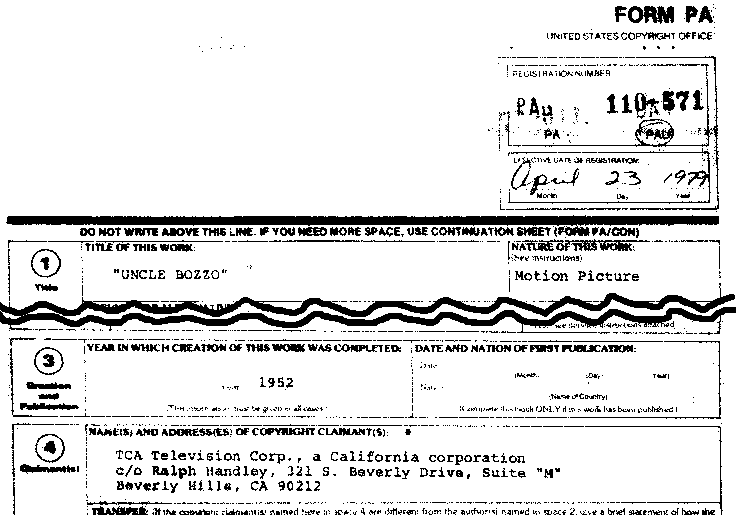
| above: Pertinent parts of the first page of the registration for a second-season episode of The Abbott & Costello Show. (Item 2 of the above page was removed from this image owing to its duplication from the previous illustration.) Notice that in item 3, the year of creation is 1952 whereas in the regisration for the first-season episode this item is given as 1951. |
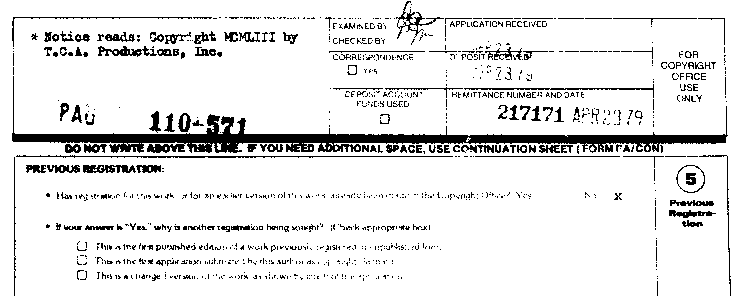
| Here is the top part of the back side of the page shown in the previous illustration.
In the part above where the form alerts registrants “Do Not Write Above This
Line,” someone has typed in the wording of the copyright notice, establishing that
the notice gives a 1953 date (the year of original broadcast) rather than 1952 (likely the
year of filming). A one-year difference does not invalidate a copyright, so this is
not a crucial matter on this registration. The registration numbers for the programs begin with “PAu” rather than “PA,” indicating that these were registered as unpublished works. Regardless of whether these would be considered published or unpublished works, the registration of these 52 episodes 26-28 years after initial broadcast was permitted (owing to the provisions added to the Copyright Law in its 1976 revision), but the registration may have been the one task needed to fulfill the copyright requirements only insofar as concerned the 26 second-season episodes. The second season episodes had contained copyright notices, and part from the issue of whether one or more may have had a notice that was in error by one year, these notices gave the public an indication that the claimant had not dedicated the programs to the public. In registering these claims with the Copyright Office in 1979, there was now a formal record. The registration of the 26 first-season episodes may have proven merely to confound those who may have been tempted to offer unauthorized copies of the episodes prior to being dissuaded by the existence of the registrations. The first-season episodes, as far as this researcher has been able to establish, never had copyright notices within the programs. For an unpublished program, this does not invalidate copyright. However, these episodes were widely syndicated after the network broadcast and thus seem unlikely to meet qualifying status as unpublished works. The extensive distribution, entailing several successive firms, makes it less likely that the claimants could mount a defense on grounds of unpublished status as could be enjoyed with a program that had not been again publicly shown after a single network broadcast.) |
Declarations of Previous Works
| When a copyright is registered for a work which incorporates material from a previous work, §409(9) of the 1976 Copyright Act mandates that the copyright registration include “an identification of any preexisting work or works that it is based on or incorporates, and a brief, general statement of the additional material covered by the copyright claim being registered.” This page reproduces portions of copyright registrations which demonstrate how this is done. |
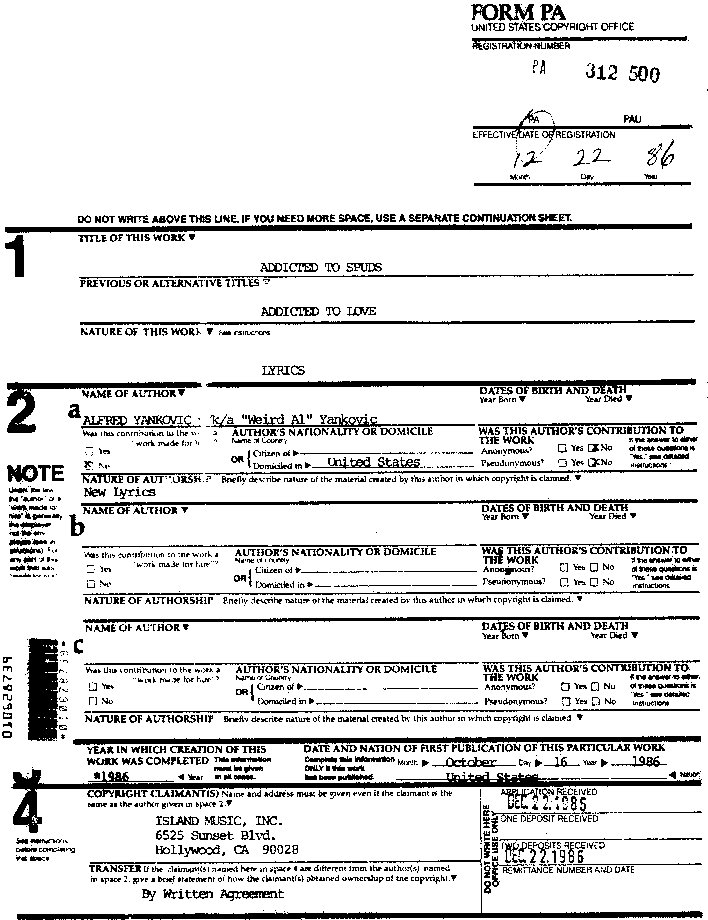
| above and below: song parodist “Weird Al” Yankovic created a new
song to the melody of “Addicted to Love,” which had been a success the previous
year for rock star/songwriter Robert Palmer. (By using some of the same words in his
lyrics, Yankovic’s version could better be described as one having a “previous
or alternate title,” which is how the earlier song was recognized on the
registration.) In that the music existed previously, the “nature of this
work” is given as “lyrics” on the registration (see item 1). Parody is a protected form of expression within American law. (See the Citation and Case Summaries page for parody of this web site for citations and documentation.) Payment to or permission from the rights-holders to the pre-existing works must be made obtained, however. At the top left of the reverse side of the page (below), a note added by the Copyright Office (it appears above the line instructing registrants “Do Not Write Above This Line”) indicates that the designation “1986” as the answer to “Year in Which Creation of This Work Was Completed” (item 3 of form) was filled in by the Copyright Office from information supplied by a representative of the registrant. This is entirely proper and does not affect the validity of the copyright. (The bottom portion of the second side of the registration form, which is irrelevant to the subjet of pre-existing material, has been omitted from the illustration.) |
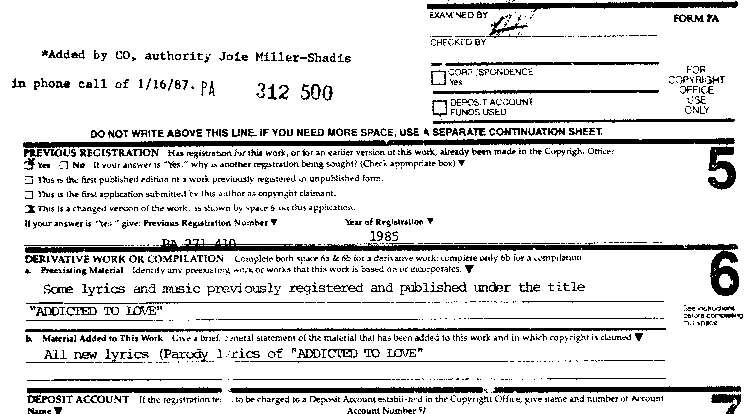
| next two images: portions of yet another registration of a song containing new lyrics by “Weird Al” Yankovic. Most of the information on the complete form is similar to that on the registration for “Addicted to Spuds,” so reproduced here are just those parts that differ from “Addicted to Spuds” in the manner of declaring the use of the pre-existing work. |
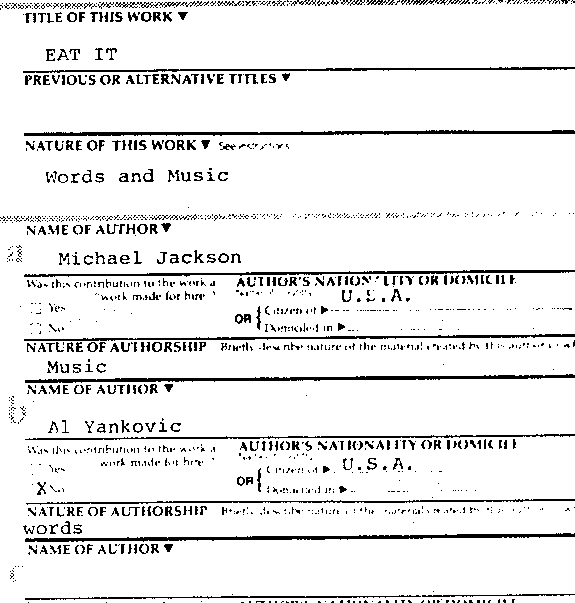
| above and below: “Eat It” is Yankovic’s parody of Michael
Jackson’s popular song “Beat It.” Against the practice used on the
“Addicted to Spuds” registration of naming the earlier song as a “Previous
or Alternative Title” and not naming the original songwriter(s) under
“Author,” the registration for “Eat It” does not name “Beat
It” as a “Previous or Alternative Title” but does name Michael Jackson as
an author (he’s named as the first author, his authorship given specifically as that
of “Music,” indicating that he is not to be considered author of the words to
such a sufficient level that he would be credited as such). On the reverse side of the page (below), the previous registration of Jackson’s version of the song is declared. The year of that version (1982) and the registration number are referenced, yet anyone reading this registration without already knowing the title of the song parodied would have to use other resources to match the previous registration number to obtain the earlier title. As on the registration for “Addicted to Spuds,” the registration declares in item 6b that the new work is new insofar as having “new lyrics” and that it these are “parody.” |

| Neither the registration for “Addicted to Spuds” nor for “Eat It”
is deficient. Each informs the reader of the existence of the pre-existing work and
the nature (and extent) of the new authorship. The next two illustrations are the registration (front and back sides) for another song by the same Al Yankovic whose parody songs have been the subjects of the previous examples on this page. Here, the declaration indicates that the particular song makes use of a dozen pieces of previously-published music by other authors but that there is also incorporated “one original [tune] (music only) by the author” (meaning Yankovic, the only author declared in item 2a). |

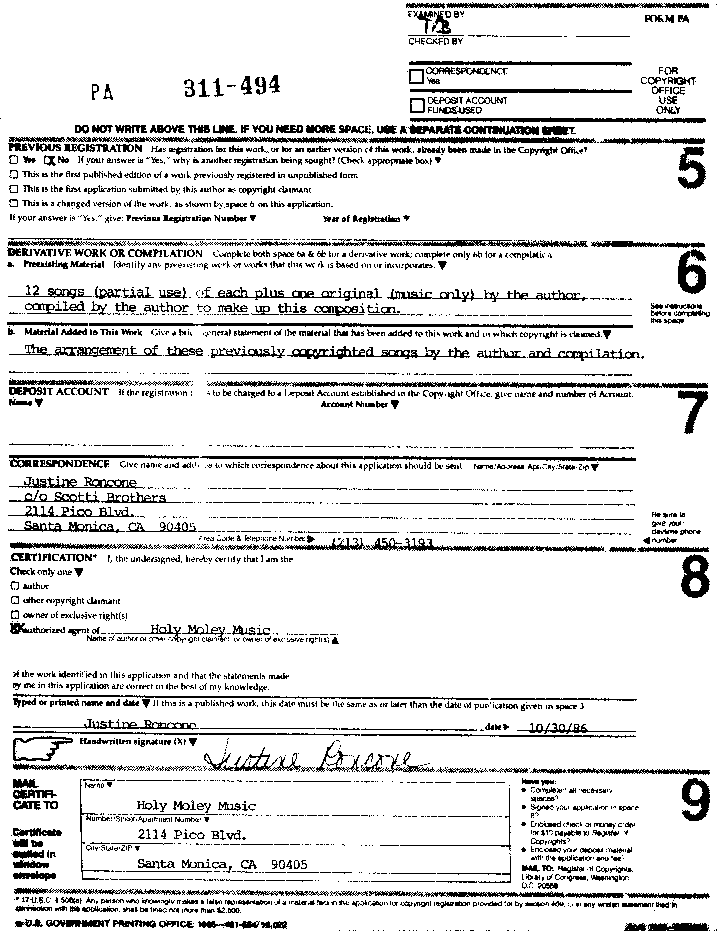
| (Stay away from your phones! Santa Monica is no longer in the 213 area
code. In any event, one can’t expect after twenty years that the authorized
agent — assuming it’s the same person as in 1986 — could be reached at the
same telephone number.) The album on which this song first appeared is also titled Polka Party. The album itself is a collection of ten distinct songs (not counting all the song interpolated where numerous pre-existing songs are “quoted” in a single Yankovic song). The album has yet another registration, but under the category of sound recording rather than as a musical composition. The various songs on the album were copyrighted separately as well as within the compilation. It would be pointless to reproduce all of them here as they follow the pattern (documented above) of referencing the pre-existing work and declaring that Yankovic parodied the original in his new lyrics. However, at least one song does declare as a basis any pre-existing work. |

| above and below: The registration for “Christmas at Ground Zero” (one of the songs on the Polka Party album) names only Yankovic as author, naming him creator of both words and music. Item 6 has been left blank, an indication that the registrant considered that there was no pre-existing material to credit nor anything from a previous registration that may be said to have been added to. |
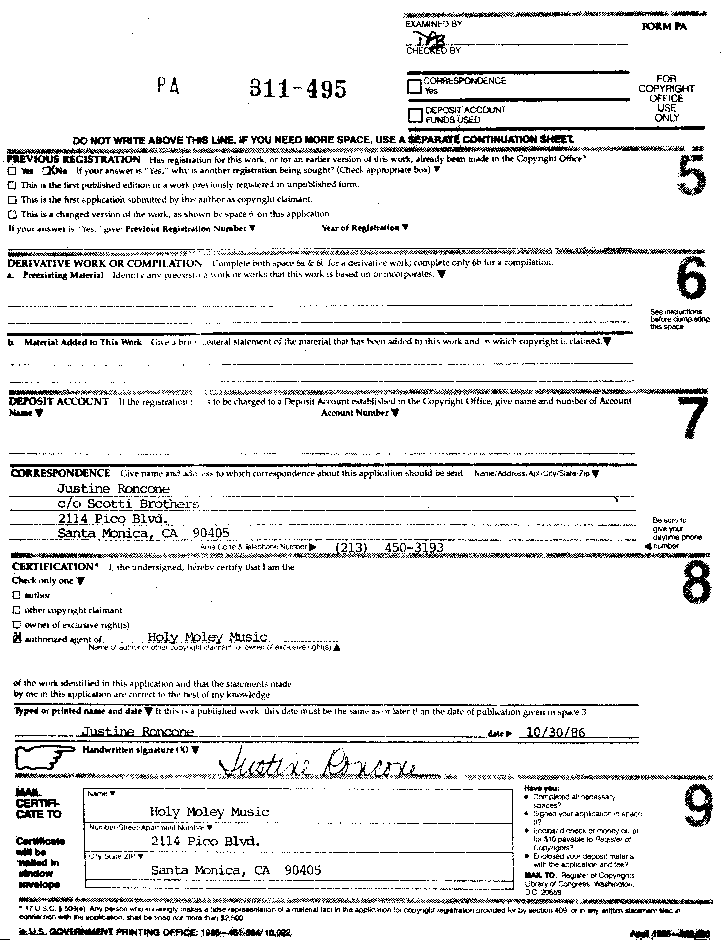
| From the information provided by the registrations for “Addicted to Spuds” and “Eat It,” it should be apparent that someone wanting to record versions with yet another set of alternative lyrics to these melodies would need to secure clearances with the holders of rights to “Addicted to Love” and “Beat It.” Yankovic (properly) never claimed ownership of the melodies he re-used. |
One can better appreciate the level of detail in modern copyright registration forms when one sees how little information is on the forms of the 1890s. Below is the bulk of the information that the Copyright Office has on its registration for two 1890s editions of the Mark Twain novel previously discusseed on the Publication in Copyright illustrations page.
| 1896 registration #22079 deposit made of Book “The Adventures of Huckleberry Finn (Tom Sawyer’s Comrade) Illustrated. New Edition from New Plates.” |
| 1899 registration #17727 “The Adventures of Huckleberry Finn (Tom Sawyer’s Comrade) Scene: ___[as per book]____ Time: ___[as per book]____ By Mark Twain. (Samuel L. Clemens.) Hartford, Conn. The American Publishing Company 1899” |
On the registration form for the 1896 edition, the book has added into it by later hand-writing: “renewed: Act 1909 No 25375”. This is a considerably less effective way of maintaining renewal information than would be practiced later. Apparently, when the time came for 1899 books to be renewed, the Copyright Office was no longer hand-writing this information onto its copies of the registrations, because registrations adjacent to the 1899 Huckleberry Finn do not have renewal information written next to them, either. More about the later practices can be gleaned from the illustrations pages on renewals and investigating copyright status.
In both cases above, Harper & Brothers deposited the book, yet notice a different publisher (apparently) at the bottom of the information concerning the 1899 deposit.
|
This page provides examples on Registration, so the passages on
|
You’ve seen the illustrations —
You’ve read the captions —
Now read passages from the law
and read what the courts decided.
Read Citations and Case Summaries on:
• Registration (including: late registrations; deficiency; duplication; group registration; group renewal)
• Work for hire
• Joint works
• Useful items (no case summaries)
• Sports
• Work classifications (no case summaries)
• Transfer recordation
• Statutory vs common-law copyright
• • •
Go to next page, where the illustrations continue (Current page will be replaced.)
